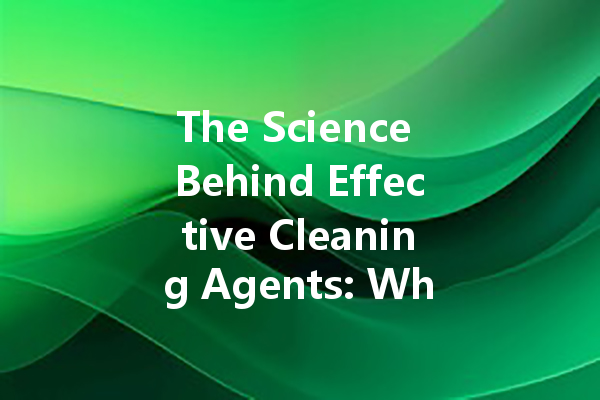In today’s world, cleanliness is more important than ever. As we continue to navigate through health concerns and heightened hygiene awareness, understanding the science behind effective cleaning agents becomes crucial. This article explores how cleaning agents work, the key ingredients that make them effective, and what to look for when choosing a cleaning product for your home or business.
Understanding Cleaning Agents
Cleaning agents are substances used to remove dirt, stains, and unwanted microorganisms from various surfaces. They come in many forms, including liquids, powders, aerosols, and gels. The effectiveness of a cleaning agent depends on its chemical composition and how it interacts with dirt and grime.
The Chemistry of Cleaning
At a molecular level, cleaning agents work by breaking the bonds between dirt and the surfaces they adhere to. This process involves several types of chemical reactions, but two main categories of cleaning agents are particularly important: surfactants and solvents.
Surfactants
Surfactants, or surface-active agents, are compounds that lower the surface tension between liquids. This property allows them to penetrate and lift dirt away from surfaces. Surfactants are often categorized into four types: anionic, cationic, nonionic, and amphoteric.
Solvents
Solvents are liquids that dissolve other substances. They play a vital role in cleaning agents because they help break down oils and grease. Common solvents in cleaning products include water, alcohol, and various organic compounds.
The Role of pH in Cleaning Efficacy

The pH of a cleaning agent significantly influences its effectiveness. pH is a measure of how acidic or basic a substance is, and it can affect the cleaning performance of a product. For instance:
Maintaining the right pH level is essential for achieving optimal cleaning results. If the pH is too high or too low for a particular application, it may not perform as expected.
Eco-Friendly Considerations
As the demand for green cleaning products rises, manufacturers are increasingly formulating cleaning agents that are biodegradable and free of harsh chemicals. Eco-friendly cleaning agents often rely on plant-based surfactants and natural solvents, which can be equally effective as traditional chemicals.
When selecting a cleaning agent, look for certifications such as EPA Safer Choice or Green Seal, which indicate that the product meets specific environmental standards.
Choosing the Right Cleaning Agent
When it comes to selecting an effective cleaning agent, consider the following factors:
Identify the Surface Type
Different surfaces require different cleaning agents. For instance, glass cleaners often contain ammonia for streak-free shine, while wood surfaces may need pH-balanced products to avoid damaging the finish.
Evaluate the Cleaning Task
Determine the specific cleaning task at hand. Is it heavy-duty grease removal or light dusting? Each task may require a different type of cleaner for optimal results.
Sensitivity and Safety
If you have sensitive skin, allergies, or children and pets at home, look for hypoallergenic and non-toxic options to create a safe environment.
Conclusion
Understanding the science behind effective cleaning agents can help consumers make informed choices about the products they use. By recognizing the roles of surfactants, solvents, and pH balance in cleaning efficacy, you can select the most appropriate cleaning agents to keep your space clean and safe. This knowledge empowers you to maintain a healthy living and working environment, ultimately contributing to your overall well-being.
